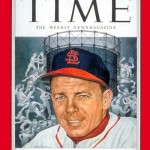Edward Raymond Stanky (September 3, 1915 – June 6, 1999[1]), nicknamed “The Brat”, was an American professional baseball player and manager. He played in Major League Baseball as a second baseman for the Chicago Cubs (1943–44), Brooklyn Dodgers (1944–47), Boston Braves (1948–49), New York Giants (1950–51) and St. Louis Cardinals (1952–53). He was born in Philadelphia, and his original nickname, “The Brat from Kensington”, is in reference to the neighborhood where he grew up.
It took Stanky eight years to reach the major leagues at age 27, after starting out at Greenville, Mississippi, in the East Dixie League, where he was a teammate of future St. Louis Cardinals star Harry Brecheen, whom Stanky would manage in St. Louis in 1952.
Stanky was famous for his ability to draw walks; he drew 100 or more walks in each of six different seasons, 140 or more in two of them. In 1946, he hit just .273 but his 137 walks allowed him to lead the league in OBP with .436, edging out Stan Musial—who led in more than ten hitting categories. His best season was probably 1950 with the Giants, when he hit an even .300 and led the league in walks (144) and OBP (.460). On August 30, he tied a major league record when he walked in seven consecutive at-bats (in two games).
Leo Durocher, who managed him with the Dodgers and Giants, once summed up Stanky’s talents: “He can’t hit, can’t run, can’t field. He’s no nice guy … all the little SOB can do is win.” Yankee shortstop Phil Rizzuto still complained years later about a notorious play during Game 3 of the 1951 World Series in which Stanky kicked the ball loose from Rizzuto’s glove as he slid into second base, instrumental in the Giant win that put them ahead two games to one, although they lost the next three and the Series with it.
As a runner at third base with less than two out, he would station himself several feet back of the bag, in shallow left field. He would time the arc of any outfield fly and then take off running, step on third as the catch was being made and continue to run at full speed, making it almost impossible to throw him out at home, a tactic eventually outlawed as a result. He was also (in)famous for what came to be called “the Stanky maneuver”, distracting opposing hitters by jumping up and down and waving his arms behind the pitcher from his second base position.
Stanky was also a master of the “delayed steal” in which the runner feigns disinterest after the pitch; but instead of walking back to first breaks for second as soon as the infielders return to their normal positions. As Cardinal player-manager, he would hold up games close to being called on account of darkness or curfew when that would benefit his team, by walking leisurely to the mound from second base or the dugout (when not playing) after every pitch to confer with his pitcher, eventually resulting in the one-trip-per-inning rule.
Contribution to breaking the color barrier
Stanky contributed to the breaking of the color barrier as a member of the Brooklyn Dodgers in 1947. When Jackie Robinson joined the Dodgers, he was treated harshly and discriminated against. Stanky stayed silent at first, but finally yelled back at Ben Chapman’s racist insults during a game. Not long afterward, the other Dodgers began to stand up for Robinson as well. The incident is portrayed in the film 42. Stanky is played by Jesse Luken.
It can be noted that Robinson, a natural second baseman, was shifted to first base in his rookie season as Stanky was already the Dodgers’ second baseman and leadoff hitter. Before the 1948 season began, Stanky was traded to the Boston Braves so that Robinson could return to his natural position and also bat leadoff.

Manager of Cardinals
He appeared in three World Series in the five years between 1947 and 1951 — with three different National League champions, the Dodgers, Braves and Giants, all of whom lost to their American League opponents. Following the 1951 World Series, in which he played in all six games for the Giants but hit an anemic .136, he was traded to the Cardinals as player-manager.
In 1952, his Cardinals won seven more games than they had in 1951 and he was chosen Major League Manager of the Year by The Sporting News even though the Redbirds didn’t move up in the standings, finishing in third place both years. But his time as Cardinal manager coincided with the slow decline of the team and its farm system from its glory days in the 1940s and the ownership transition from Fred Saigh to August “Gussie” Busch, and on May 27, 1955, after a 17–19 start, he was fired.
Cardinal Player Stats
- 2 years
- 70 games
- 113 at bats
- .239 batting average
